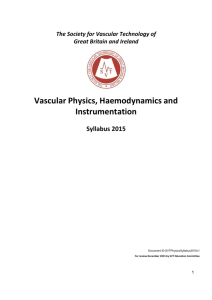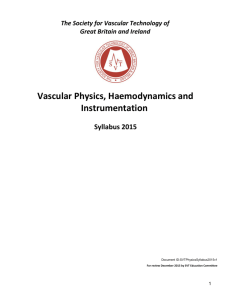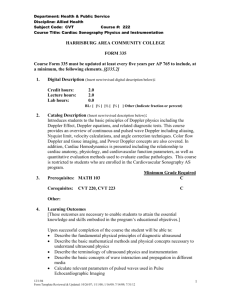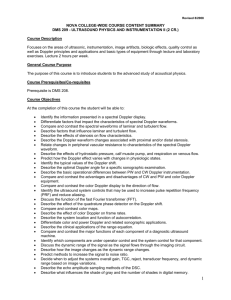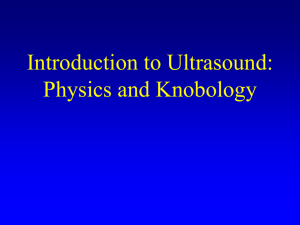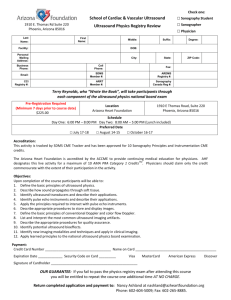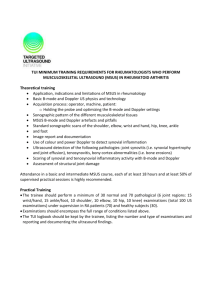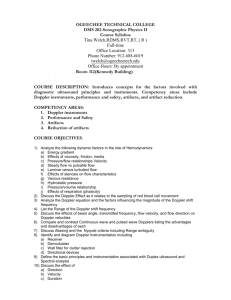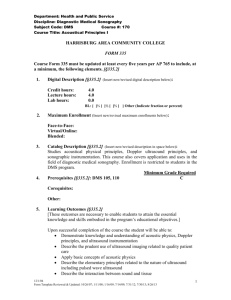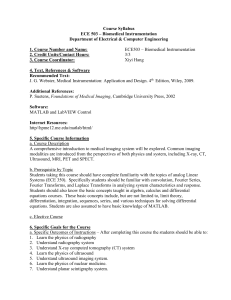B. Principles of Ultrasound Imaging (35%)
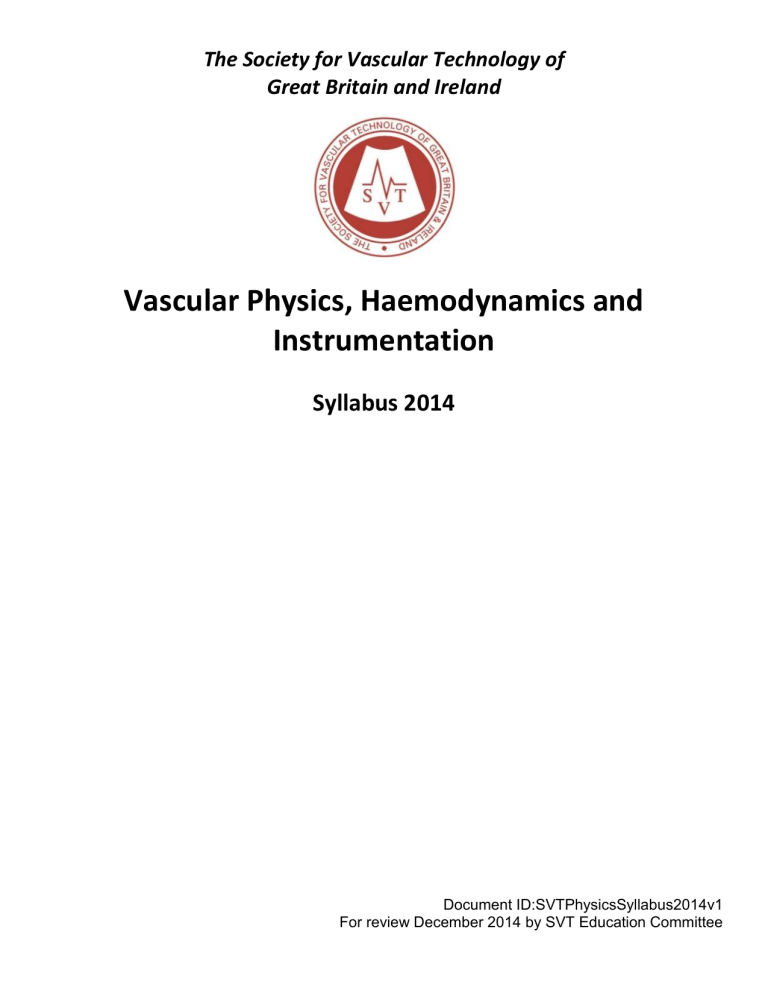
The Society for Vascular Technology of
Great Britain and Ireland
Vascular Physics, Haemodynamics and
Instrumentation
Syllabus 2014
Document ID:SVTPhysicsSyllabus2014v1
For review December 2014 by SVT Education Committee
A. Principles of Ultrasound, Transducers and Instrumentation (35%)
Elementary Principles of Ultrasound
Definition of ultrasound
Differentiation between audible sound and ultrasound
Propagation of vibration
Compression
Rarefaction
Frequency
Wavelength
Propagation speed
Density
Period
Amplitude
Pressure
Power
Intensity
Decibels
Units of measurement
General Physics Principles
Voltage, current, charge
Ohm’s law
Power
Intensity
Units of measurement
Propagation of Ultrasound through Tissues
Average speed of ultrasound in tissues
Speed of ultrasound through air, bone and specific tissues
Reflection
Acoustic impedance
Refraction
Scattering
Attenuation
Absorption
Units of measurement
Ultrasound Transducers
Piezoelectric effect
Piezoelectric materials
Transducer construction and characteristics o Crystal thickness o Speed of sound in crystal material o Frequency characteristics o Bandwidth o Quality factor o Damping
Sound beam characteristics o Interference phenomenon o Huygen’s principle o Near field characteristics o Far field characteristics o Beam focusing
2
o Beam steering o Effect of transducer frequency on beam characteristics
Lateral resolution
Axial resolution
Slice thickness resolution
Mechanical transducer construction and characteristics
Electronic transducer construction and characteristics
Pulse-Echo Instruments, Storage and Display
Continuous wave instrumentation
Pulsed wave instrumentation
Bi-directional Doppler instrumentation
Uni-directional Doppler instrumentation
Transmitter
Receiver o Amplification o Compensation o Compression o Demodulation o Rejection
Scan Converter
Image storage
Digital devices o Binary system o Analogue and digital converters o Digital memory
Pre-processing functions
Post-processing functions
Display devices
Recording and archiving techniques o Video format o Digital format o PACS (picture archiving communication system)
B. Principles of Ultrasound Imaging (35%)
Pulse-Echo Imaging
A-mode, B-mode, 3-D, and M-mode definitions
Principles of real time B-mode image formation
Principles of 3-D image formation
Grey scale display
Dynamic range
Frame rate
Number of lines per frame
Number of focal regions
Field of view
Image depth
Gain
Time gain control (TGC)
Image resolution
Temporal resolution
Range equation
Pulse repetition frequency
Pulse repetition period
Pulse duration
3
Spatial pulse length
Compound imaging
Tissue harmonic imaging
Doppler Physics Principles
Doppler effect
Doppler equation
Doppler frequency shift
Factors affecting the magnitude of the Doppler frequency shift
Reflector Speed
Audible Doppler signal analysis
Continuous wave Doppler
Pulsed wave Doppler
Spectral Doppler Imaging
Basic principles
Spectral analysis
Fast Fourier Transform spectrum analysis
Spectral Doppler display
Direction
Velocity
Duration
Magnitude
Sample volume size
Zero baseline
Pulse repetition frequency (PRF)
Wall filter
Doppler gain
Spectral broadening
Aliasing
Diagnostic measurements o Pulsatility index o Resistive index o Volume flow
Colour flow imaging
Basic principles
Sampling methods
Reflector direction
Average velocity
Velocity variance
Autocorrelation
Time domain processing
Colour box size
Frame rate
Ensemble length
Line density
Maximum depth
Hue
Saturation
Luminance
PRF
Colour display baseline
Wall filter
Colour gain
Colour frame rate
4
Contrast agents and harmonic imaging
Artifacts
Aliasing
Power Doppler o Basic principles o Displayed information o Advantages and limitations
Artifacts associated with resolution
Artifacts associated with propagation o Reverberation o Comet tail o Mirror image o Multi-path side lobes o Grating lobes o Refraction o Speed error o Range ambiguity
Artifacts associated with attenuation o Shadowing o Enhancement o Focal enhancement o Focal banding
Artifacts associated with Doppler and colour flow imaging o Aliasing o Slice thickness o Reverberation o Mirror imaging o Ghosting o Flash o Registration o Incident beam angle o Clutter
Artifacts associated with electronic noise
Artifacts associated with equipment malfunction
C. Haemodynamics, Physiology and Fluid Dynamics (20%)
Arterial Haemodynamics
Energy gradient
Effects of viscosity, friction and inertia
Pressure/flow relationships
Velocity
Steady flow
Laminar flow
Disturbed flow
Turbulent flow
Pulsatile flow
Effects of stenosis on flow characteristics (direction, steal phenomenon)
Effects of occlusion on flow characteristics (direction, steal phenomenon)
Velocity
Acceleration
Entrance / exit effects
Diameter reduction
Peripheral resistance
Collateral effects
5
Effects of exercise
Hyperaemic response
Bernoulli’s equation
Poiseuille’s equation
Reynolds Number
Venous Haemodynamics
Venous resistance
Hydrostatic pressure
Pressure / volume relationship
Effects of respiration
Effect of oedema
Effects of muscle pump action o At rest o Contraction o Relaxation
Tissue Mechanics / Pressure Transmission
Venous occlusion by limb positioning
Superficial venous occlusion by tourniquet
Volume changes caused by blood inflow/outflow variation
Arterial occlusion by tourniquet (effect of oedema, calcification)
Arterial pressure measurements
Venous pressure measurements
Plethysmography
Two-wire/four-wire resistance measurements, graphical recording, calibration, AC/DC
Coupling
Photoplethysmography
Impedance plethysmography
Displacement (pneumatic cuff)
Strain gauge
Oculoplethysmography pressure
D. Quality Assurance and Ultrasound Safety (10%)
Instrument Performance, Evaluation, Maintenance and Safety
Quality assurance programs
Methods for evaluating equipment performance
Test objects or tissue equivalent phantoms
Doppler flow, string or belt phantoms
Equipment parameters evaluated using test objects or phantoms
Acoustic output quantities o Pressure o Power o Intensity
Spatial and temporal considerations
Average and peak intensities
SATA
SPTA
SPPA
SPTP
Methods for determining pressure, power and intensity
Acoustic exposure
6
Acoustic output labelling o Thermal index o Mechanical index
Maintenance of equipment
Electrical and mechanical hazards
Biological Effects and Safety
Primary Mechanisms of Biological Effect Production o Cavitation o Thermal
7
